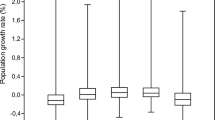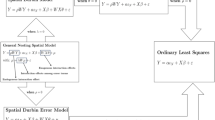Abstract
This paper explores the relationship between population growth, agricultural production, and urban development. Ongoing debate in the literature regarding the relationship between population and economic development is restricted by the limited availability of time series data and the difficulty of evaluating causality using cross-sectional data. This analysis uses the special case of Jordan with its massive refugee flows to evaluate the influence of a sudden and exogenous change in population in urban areas on the intensification of agricultural production. Spearman Rank Order correlations are calculated from time series data to show that the districts which experienced the most rapid population growth and increases in population density also exhibited the largest increases in agricultural intensity. Cross-sectional analysis in which measures of agricultural intensification were predicted by population density and urbanization factors reveals a significant interaction between density and urban centrality, where ‘centrality’ is an indicator of the accessibility of urban goods to rural communities. The results suggest that population density has a strongly positive effect on agricultural intensity in areas with few urban goods and services available, whereas the influence of population density on agricultural intensity is substantially reduced in areas with a greater diversity of urban goods and services.
Similar content being viewed by others
References
Abujaber, R.S. (1989).Pioneers over Jordan: The frontier of settlement in Transjordan, 1850–1914. London: I.B. Tauris & Co.
Bartlett, A. (1994). Reflections on sustainability, population growth, and the environment,Population and Environment: A Journal of Multidisciplinary Studies 16(1): 5–35.
Berry, B.J.L. and Garrison, W. (1958). The functional bases of central place systems,Economic Geography 33: 145–54.
Berry, B.J.L. and Parr, J. (1988).Market centers and retail location: Theory and applications. Englewood Cliffs, NJ: Prentice Hall.
Bilsborrow, R.E. (1987). Population pressure and agricultural development in developing countries: A conceptual framework and recent evidence,World Development 15: 183–203.
Birdsall, N. (1977). Analytical approaches to the relationship of population growth and development,Population and Development Review 3(7): 63–102.
Blanchet, D. (1991). On the relationship between population growth and economic growth,Population and Development Review 17(1): 105–114.
Boserup, E. (1965).The conditions of agricultural growth: The economics of agrarian change under population pressure. London: George, Allen and Unwin.
Boserup, E. (1981).Population and technological change: A study of long term trends. University of Chicago Press.
Boserup, E. (1987). Population and technology in preindustrial Europe,Population and Development Review 13: 691–701.
Cassen, R.H. (1976). Population and development: A review,World Development 4: 785–830.
Davies, W. (1967). Centrality and the central place system,Urban Studies 4: 61–79.
Daly, H. (1991). Sustainable development: From concept and theory to operational principles, in: K. Davis and M. Bernstam (eds.),Resources, environment, and population: present knowledge, future options. New York: Oxford University Press, pp. 25–43.
Doan, P.L. (1988).Urban centrality and agricultural productivity: A model of interdependent development with implications for regional planning in Jordan. Unpublished Ph.D. Dissertation. Ithaca, NY: Cornell University.
Doan, P.L. (1991). Changing administrative regions in Jordan: Regional development strategy or distraction?,Tijdschrift voor Economische en Sociale Geografie 82(3): 177–184.
Ehrlich, P. (1968).The population bomb. New York: Ballantine Books.
Ehrlich, P. and Ehrlich, A. (1990).The population explosion. New York: Simon & Schuster.
Frankfort, H. (1951).The birth of civilization in the Near East. Garden City, NJ: Doubleday.
Glover, D.R. and Simon, J.L. (1981). The effect of population density on infrastructure: The case of road building,Economic Development and Cultural Change 29: 749–758.
Gubser, P. (1983).Jordan: Crossroads of Middle Eastern events. Boulder, CO: Westview Press.
Haggblade, S., Hazell, P., and Brown, J. (1989). Farm-nofarm linkages in rural sub-Saharan Africa,World Development 17(8): 1173–1201.
Hardin, G. (1968). The tragedy of the commons,Science 162: 1243–4.
Hodgson, D. (1988). Orthodoxy and revisionism in American demography,Population and Development Review 14(4): 541–569.
Kanaan, W. and Attieh, Y. (1974).Jordan: Agricultural development. Amman: Jordan Press Foundation.
Kelley, A.C. (1988). Economic consequences of population change in the Third World,Journal of Economic Literature 26: 1685–1728.
Keyfitz, N. (1991). Toward a theory of population-development interaction, in: K. Davis and M. Bernstam (eds.),Resources, environment, and population: present knowledge, future options. New York: Oxford University Press, pp. 295–314.
Keyfitz, N. (1993). Population and sustainable development: Distinguishing fact and preference concerning the future human population and environment,Population and Environment: A Journal of Multidisciplinary Studies 14(5): 441–461.
Khamis, M. (1985). Population growth in the cities of the Irbid Governorate, Jordan,Population bulletin of ESCWA 27: 127–143.
Khouri, R. (1982).The Jordan Valley: Life and society below sea level. London: Longman.
Konikoff, A. (1947).Transjordan: An economic survey. Jerusalem: Economic Research Institute of the Jewish Agency for Palestine.
Marshall, J.U. (1969).The location of service towns. Toronto: University of Toronto Press.
Mazur, M. (1979).The economic development of Jordan. London: Croom Helm.
McNicoll, G. (1984). Consequences of rapid population growth: An overview and assessment,Population and Development Review 10: 177–240.
Meadows, D.H., Meadows, D.L., Randers, J., and Behrens W.W. (1972).The limits to growth. New York: Universe Books.
Pedhazur, E.J. (1982).Multiple regression in behavioral research: Explanation and prediction, 2nd ed. New York: Holt, Rhinehart & Winston.
Phillips, P.G. (1954).The Hashemite Kingdom of Jordan: Prolegomena to a technical assistance program. Chicago: University of Chicago, Department of Geography, Research Paper No. 34.
Rondinelli, D. and Ruddle, K. (1978).Urbanization and rural development: A spatial policy for equitable growth. New York: Praeger Press.
Rondinelli, D. (1987). Cities as agricultural markets,Geographical Review 77: 408–420.
Ruttan, V.W. (1955). The impact of urban-industrial development on agriculture in the Tennessee Valley and the Southeast,Land Economics 37: 38–56.
Samha, M. (1980). Migration of refugees and non-refugees to Amman, 1948–1977,Population Bulletin of ECWA 19: 47–67.
Samha, M. (1984). Shifts of the demographic weights of Jordanian Cities: 1952–1979,Population Bulletin of ECWA 24: 93–126.
Simon, J. (1981).The ultimate resource. Princeton: Princeton University Press.
Simon, J. (1989). On aggregate empirical studies relating population variables to economic development,Population and Development Review 15(2): 323–332.
Simon, J. and Gobin, R. (1980). The relationship between population and economic gowth in LDC's, in: J. Simon and J. Davanzo (eds.),Research in Population economics, Vol. 2. Greenwich, CT: JAI Press, pp. 215–234.
Swaney, J. (1991). Julian Simon versus the Ehrlichs: An institutionalist perspective,Journal of Economic Issues 25(2): 499–509.
Taeuber, I. (1958). Population and political instability in underdeveloped areas, in P. Hauser (ed.),Population and world politics. Glencoe, IL: The Free Press.
Tauriainen, J. and Young, F. (1976). The impact of urban-industrial development on agricultural income and productivity in Finland,Land Economics 52: 192–206.
Weir D.P. (1991). A historical perspective on the economic consequences of rapid population growth, in: G. Tapins, D. Blanchet and D. Horlacher (eds.),Consequences of rapid population growth in developing countries. New York: Taylor & Francis, pp. 41–66.
World Bank. (1957).The economic development of Jordan. Baltimore: the Johns Hopkins University Press published for the World Bank. Report of a Mission to Jordan.
Yanarella, E.J. and Levine, R.S. (1992). Does sustainable development lead to sustainability?,Futures October: 759–774.
Author information
Authors and Affiliations
Corresponding author
Rights and permissions
About this article
Cite this article
Doan, P.L. Population density, urban centrality, and agricultural intensification in Jordan. Popul Res Policy Rev 14, 29–44 (1995). https://doi.org/10.1007/BF01255686
Issue Date:
DOI: https://doi.org/10.1007/BF01255686




